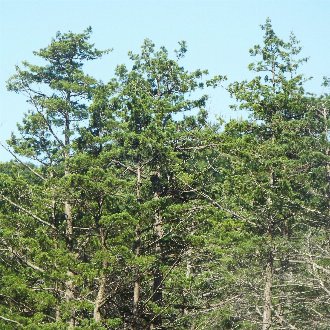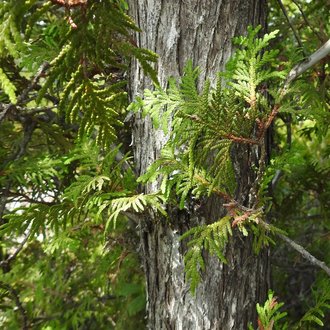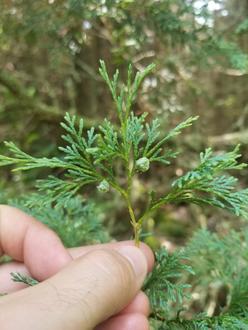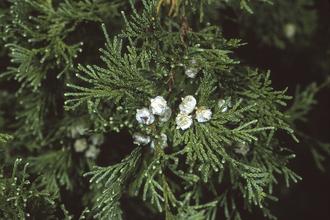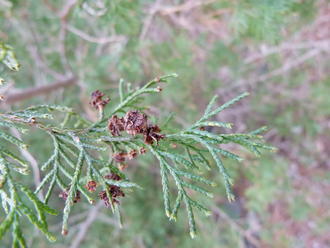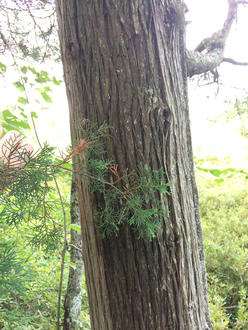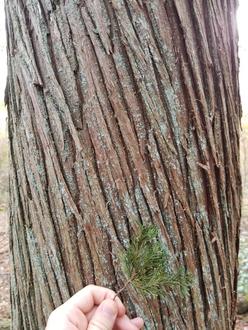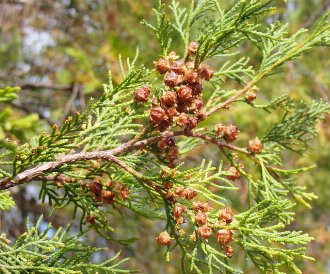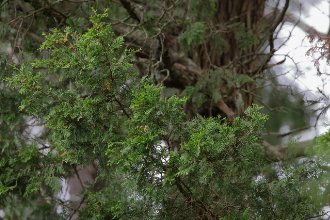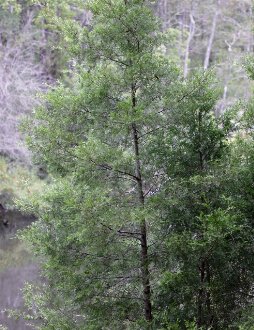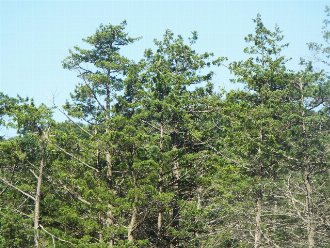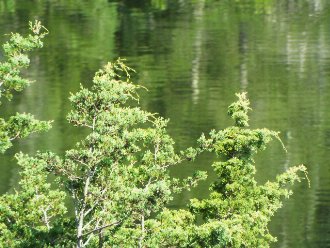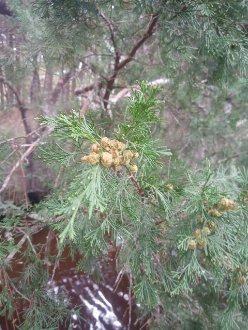Atlantic White Cedar (Chamaecyparis thyoides (L.) Britton, Sterns & Poggenb.)
Also known as Atlantic white-cedar, Southern white cedar, Atlantic white cypress, southern white cedar, whitecedar, false-cypress.
↑Summary
An evergreen conifer native to acidic, sandy wetlands of the Atlantic and Gulf coasts.
↑Range - Expand
| Legend | Color |
| Introduced | |
| Native | |
| Native or Not Present | |
| Not Present |
This map is based on our research. We have checked its accuracy to Level 3 ecoregions. Although this plant occurs somewhere in each of these regions, it may only occur in a small part of some or all of them.
Although this species rarely survives in the wild outside its native range, there is a naturalized population established from planted plants in Spruce Flats Bog, Westmoreland County, PA.
↑Similar Plants
↑Habitat
Atlantic White Cedar is found in the coastal plain along the Atlantic and Gulf coasts and slightly inland, in acidic wetlands underlain by sand. Natural habitats include bogs, swamp forests, moist depressions, glacial kettles, areas along streams and rivers, and other low, wet areas.
This species is quite particular about soil conditions, including both pH and texture. It occurs in nutrient-poor, acidic soils (pH 3.5 to 5.5), usually on soils where organic muck or peat is underlain by sand, but is usually absent from areas where peat is underlain by or intermixed with silt or clay. It is often found on sites that experience seasonal flooding up to 1-2 feet, but are drier in summer. Trees often occur in swamps where there is perpetual standing water, but are located on mounds just elevated enough that the base of the trunk dries out occasionally.
Atlantic White Cedar not only needs sandy soils on the sites where it grows, but also in the broader surroundings, as this leads to a more stable water table. Regions with clayey or other poorly-drained soils experience too much fluctuation of water table height during wet or dry spells, leading this species to usually be absent even from locally-sandy wetlands.
Humans have greatly reduced the habitat for this species through drainage of wetlands, as well as the cultivation of wetland crops, mainly cranberries, in former bogs and swamps. Even where good habitat for this species exists, humans have greatly reduced its populations by logging. The largest remaining habitat is the Great Dismal Swamp in Virginia and North Carolina, where this tree is abundant.
↑Life Cycle
Open-grown trees mature rapidly and begin producing seed at 3 to 5 years of age, with good seed production starting as early as the fourth year. Trees growing with competition may not produce seed until 10-20 years of age.
Seeds are lightweight and wind-dispersed; seeds do not always germinate immediately and form a short-term seed bank, with some germinating within a year but others not germinating for 2 years or more.
Seedlings establish best in open peat, rotting wood, sphagnum moss, or muck. They do not establish as well in litter from pine needles or hardwood leaves. Seedlings are initially sensitive to both drought and flooding. Seedlings initially have sharp needle-like foliage, but switch to scale-like growth relatively quickly.
Trees can live over 1,000 years, but most trees rarely live longer than 200 years. Trees most often die by windthrow and can also be damaged by limb breakage during storms. Trees that have not reached the canopy can also die if being overtopped by more shade-tolerant hardwoods such as red maple (Acer rubrum) or tupelo (Nyssa sp.), or on better-drained sites, by American holly (Ilex opaca), or in the south of its range, swamp bay (Persea palustris) or swamp titi (Cyrilla racemiflora).
↑Faunal Associations
This species is a preferred deer browse in much of its range, and seedlings are particularly favored. Meadow mice also eat seedling stems. The fruit, however, have low palatability to birds and mammals.
Trees are also important as cover for mammals and birds during winter. Their tendency to grow in dense stands where they are typically the tallest evergreen trees in their habitats makes them particularly valuable for cover, both as a hiding place and in providing shelter from wind.
Several warblers, including the yellow-throated warbler, prairie warbler, and hooded warbler, utilize this species for nesting habitat, usually nesting low to the ground in stands. Pileated woodpeckers nest in cavities.
Larvae of several lepidoptera species eat various parts of this tree, and these species span the full range from specialists on this species, to ones feeding on closely-related plants, to generalists eating many tree species. Hessel's hairstreak (Callophrys hesseli), which is a specialist on this species, has become vulnerable because of the decline of this species. This species is also eaten by the larvae of the baldcypress sphinx moth (Isoparce cupressi), which prefers bald cypress (Taxodium distichum) but also eats this species. The generalist evergreen bagworm (Thyridopteryx ephemeraeformis) prefers this species and other Cupressoideae. Even more generalist is the imperial moth (Eacles imperialis) which has been recorded eating this species, but likely does not prefer it.
↑Uses
Atlantic white cedar is occasionally planted as a landscaping plant, including outside its native range. It is valued for its attractive form and tolerance of both wet conditions and soil erosion. In landscaping, it can survive on better-drained sites and higher-pH sites than it would occur on in the wild, and it can be grown well inland from its native range. However, it has poor drought tolerance, even relative to other wetland trees, and is also susceptible to damage from deer browsing, which can be more severe when it is grown on dry ground where deer can more easily access it.
Usually, landscaping use is restricted to cultivars selected for having a shorter maximum height. The wild type of this species is often a poor choice for planting around buildings, roads, and paths because it grows very tall and is prone to windthrow, especially when grown in isolation, thus posing a risk of injury or property damage. In the wild, this species often forms large stands where trees are collectively sheltered by each other from wind, and it also tends to occur on the lowest points around, providing at least some topographic shelter.
The wood is valued for being highly rot-resistant, easy to work with, and having a straight grain and uniform texture. It also has a similar fragrance to other so-called "cedars". Although a desirable wood, it is not quite as hard or strong as that of its close relative on the west-coast, the Port Orford cedar (Chamaecyparis lawsoniana). The wood tends to be expensive relative to other conifers, both because of its desirable properties and low availability.
Although this species lends itself well to commercial harvest, responding well to clearcutting, presently there is little commercial cultivation, limited to a few small areas in North Carolina, due to a combination of habitat destruction, overharvest, and mismanagement of stands.
In some parts of the south, this species is used as a Christmas tree.
This species has been used in ecological restoration plantings and for the rehabilitation of disturbed wetlands, and is probably under-utilized to this end. It is relatively easy to propagate on a large scale either by seed or cutting. However the species' narrow habitat preferences need to be considered in such plantings. The Tennessee Valley Authority has planted it outside its native range, along shorelines of reservoirs created by damming, but these plantings failed to form sustaining wild populations, probably due to a combination of mismatched soil types (higher pH and poorer-drained) and steeper topography leading to water levels oscillating more than it could handle.
↑Related Plants
There are several other Chamaecyparis species, including ones native to North America and elsewhere. This species is closely related to the Port Orford cedar (Chamaecyparis lawsoniana), which is native to the west coast, as well as the Japanese cypress (Chamaecyparis obtusa), which has become established in the wild in New York State. Outside its genus, it is probably closest-related to Fokienia hodginsii, which does not occur in North America. None of these overlap in range in the wild, although they can occasionally occur in landscaping in this species' range.
Numerous other species belong to the broader Cupressoideae grouping. Among these, it is slightly less closely related to the incense cedar (Calocedrus decurrens), native to the West Coast, the oriental arborvitae (Platycladus orientalis), various Junipers (Juniperus sp.), and three genera that do not occur in North America: Cupressus, Tetraclinis, and Microbiota. Of the junipers, the one that overlaps most in range is eastern redcedar (Juniperus virginiana).
It even more distantly related to the northern white-cedar (Thuja occidentalis), which only overlaps with its range in a small portion of New England, and to Thujopsis dolabrata, which does not occur in North America.
↑Links & External Resources
• Atlantic White Cedar | The Wood Database (About This Site)
• Atlantic White-Cedar | Fire Effects Information System (FEIS) (About This Site)
• Chamaecyparis thyoides (Atlantic White Cedar) | USDA PLANTS Database (About This Site)
• Chamaecyparis thyoides | Go Botany (About This Site)
• Chamaecyparis thyoides (White Cypress) | Missouri Botanical Garden Plant Finder (About This Site)
• Atlantic White-Cedar | Virginia Tech Dendrology Factsheets (About This Site)
• Atlantic White-Cedar | Silvics of North America (About This Site)
• Chamaecyparis thyoides | Biota of North America Project (BONAP) (About This Site)
• Chamaecyparis thyoides | NatureServe Explorer (About This Site)
• Chamaecyparis thyoides | Flora of North America (About This Site)
• Atlantic White Cedar | Maryland Biodiversity Project (About This Site)
• Chamaecyparis thyoides (L.) Britton, Sterns & Poggenb. | Plants of the World Online (POWO) (About This Site)
• Chamaecyparis thyoides (L.) BSP (Atlantic White Cedar) | Digital Atlas of the Virginia Flora (About This Site)



